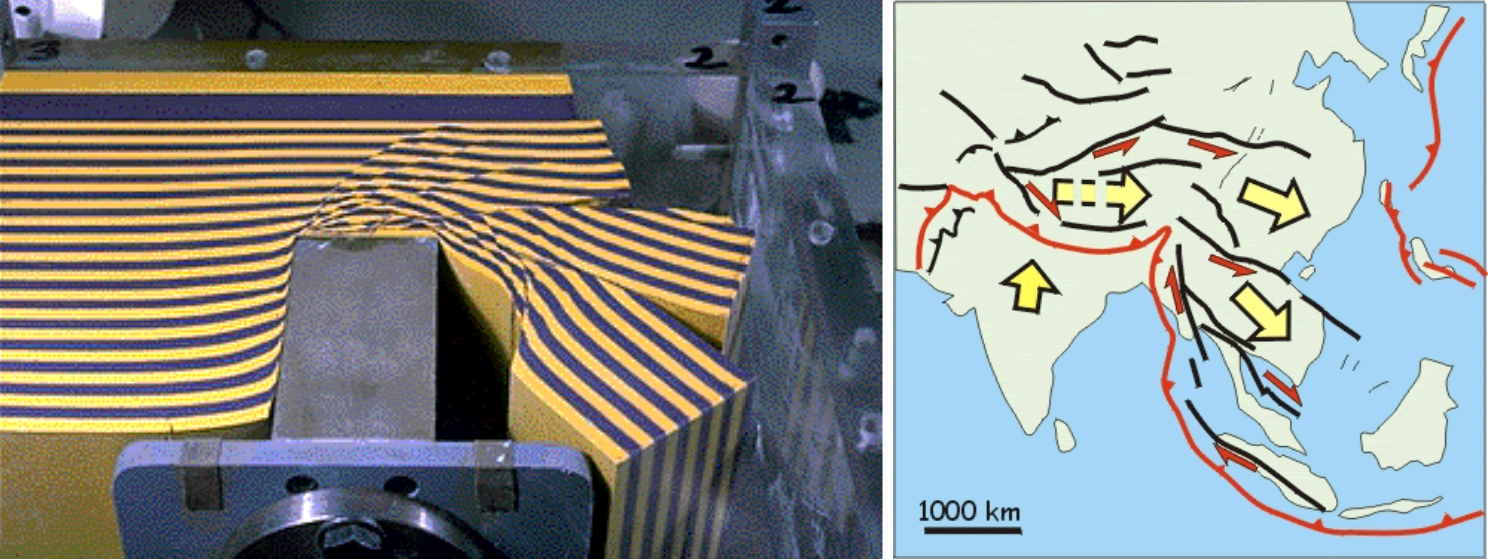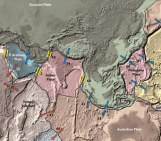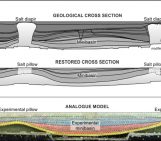
In “Propagating extrusion tectonics in Asia: New insights from simple experiments with plasticine”, Tapponnier and co-authors (1982) describe one of the most famous analogue experiments in the history of Earth Sciences. The experiment was performed in the laboratories of Rennes (France), at the beginning of the ‘80s. The article aims to shed light onto the large-scale effects caused by the India-Eurasia collision, such as the origin of the continental-scale strike-slip faults and basins of SE Asia.
The authors first summarize their previous work on indentation. They describe the experimental “cm-scale” setup next as well as the material and the tricks used to visualize the deformation to finally discuss the results of the modeling by comparing bilaterally and unilaterally confined experiments. In doing so, they assess the effects in plane strain of a free lateral boundary of the region at the borders of an indenter, and they compare it with the tectonics of Asia and SE Asia.
Tapponnier et al., (1982) clearly demonstrated that indenter-tectonics triggers the large-scale strike-slip faults documented in the field (Sagaing, Red River and Altin Tagh-Gansu-Wei faults, in Burma, China-Vietnam and China, respectively), but also the remarkable continental block escape and rotation in SE Asia. The key example of the latter is Indochina, which has ~ 800 km of extrusion and ~ 25° of rotation. The authors argue that strain is not distributed the same way when a free lateral boundary is present or not: deformation is strongly asymmetric by rapidly joining the free lateral boundary, allowing blocks to laterally move and rotate. They also show that intracontinental extensional basins can open along these strike-slip faults, such as the Baïkal rift (with rift-related magmatism; Yang et al., 2018). These rift basins at the tip of large strike-slip structures may evolve into oceanic basins when a free boundary exists, as it was the case of the South China Sea and Andaman Sea.
Eventually, in the discussion, the authors predict that the Shansi rift could potentially evolve into an oceanic basin, and that the next main rift and subsequent oceanic domain may develop in the Sea of Okhotsk, behind the Kuril islands. They additionally leave an open question about reversal of the sense of motion along the strike-slip faults, as documented along the Red River fault, and on the possibility that mantle flow could play a role in the tectonic evolution of SE Asia.

Fig. Analogue experiment with colored plasticine representing Eurasia and an indenting block representing India (http://www.geosci.usyd.edu.au/users/prey/ACSGT/Module2/Mod2Lectures/Sld032.htm);
Tectonic sketch of India and Eurasia with continental blocks motion (https://www.see.leeds.ac.uk/structure/dynamicearth/himalayas/deformation/models.htm).
The experiment is well-set but simple. Despite its limitations, which are acknowledged and clearly stated, the experiment provides key structural and kinematic information and allows to derive plane strain or plane stress. The experiment was aimed to investigate the large-scale consequences of continental indentation and extrusion, instead of reproducing typical shortening structures and thrust faults observed in convergence settings. Their approach to a faulting-dominated continental collision contributed significantly to the debates on intracontinental tectonics in the ‘70s and ‘80s. In fact, the authors’ observation on the role of strike-slip faults and the accommodation of strain at their tips as rifts and marginal basins posed the basis for the reconstruction of the tectonic evolution of SE Asia (e.g. Lee and Lawver, 1995; Hall, 2002; Curray, 2005). The claims emerging from this paper are still relevant today in the frame of the crustal flow under the eastern Himalayan syntaxis, which, although more distributed, seems to be accommodated by the same strike-slip fault systems (e.g. Copley and McKenzie, 2007; Rangin et al., 2013), but also in the frame of mantle suction and toroidal flow, triggered possibly by subduction roll-back (Sternai et al., 2014).
Tapponnier et al. (1982) stimulated an interesting discussion on Reddit, to which David Fernández-Blanco, Silvia Crosetto and Gianluca Frasca contributed. The main points discussed concern how simple yet efficient plasticine analogue experiments are in reproducing large-scale tectonic; the dominance of faulting-dominated during continental collision, and the role played by extruding strike-slip faults, and the opening venues that this contribution offered.
Written by Gianluca Frasca, Benoît Petri, Pan Luo, Silvia Crosetto, and David Fernández-Blanco with the Must-read team
References
Copley A, McKenzie D. Models of crustal flow in the India-Asia collision zone. Geophysical Journal International. 2007 May 1;169(2):683-98, doi: 10.1111/j.1365-246X.2007.03343.x
Curray JR. Tectonics and history of the Andaman Sea region. Journal of Asian Earth Sciences. 2005 Apr 1;25(1):187-232, doi: 10.1016/j.jseaes.2004.09.001
Hall R. Cenozoic geological and plate tectonic evolution of SE Asia and the SW Pacific: computer-based reconstructions, model and animations. Journal of Asian Earth Sciences. 2002 Apr 1;20(4):353-431, doi: 10.1016/S1367-9120(01)00069-4
Lee TY, Lawver LA. Cenozoic plate reconstruction of Southeast Asia. Tectonophysics. 1995 Dec 15;251(1-4):85-138, doi: 10.1016/0040-1951(95)00023-2
Rangin C, Maurin T, Masson F. Combined effects of Eurasia/Sunda oblique convergence and East-Tibetan crustal flow on the active tectonics of Burma. Journal of Asian Earth Sciences. 2013 Oct 25;76:185-94, doi: 10.1016/j.jseaes.2013.05.018
Sternai, P., Jolivet, L., Menant, A., Gerya, T., 2014. Driving the upper plate surface deformation by slab rollback and mantle flow. Earth and Planetary Science Letters 405, 110–118. https://doi.org/10.1016/j.epsl.2014.08.023
Tapponnier P, Peltzer GL, Le Dain AY, Armijo R, Cobbold P. Propagating extrusion tectonics in Asia: New insights from simple experiments with plasticine. Geology. 1982 Dec 1;10(12):611-6, doi: 10.1130/0091-7613(1982)10%3C611:PETIAN%3E2.0.CO;2
Yang, H., Chemia, Z., Artemieva, I.M., Thybo, H., 2018. Control on off-rift magmatism: A case study of the Baikal Rift Zone. Earth Planet. Sci. Lett. 482, 501–509. https://doi.org/10.1016/j.epsl.2017.11.040




Allan Lopez
Superb !
Is there any software to model the indenters and their effects ?
I do have all the input data, I am ready to start join collaboration !
Best,
Allan López